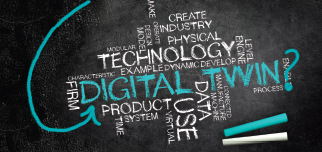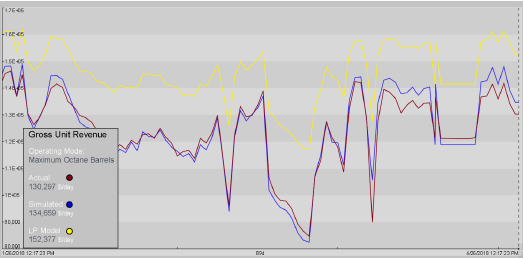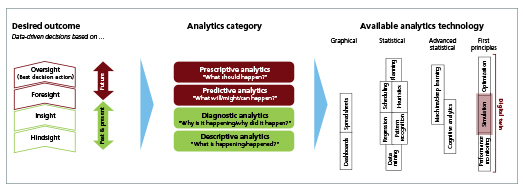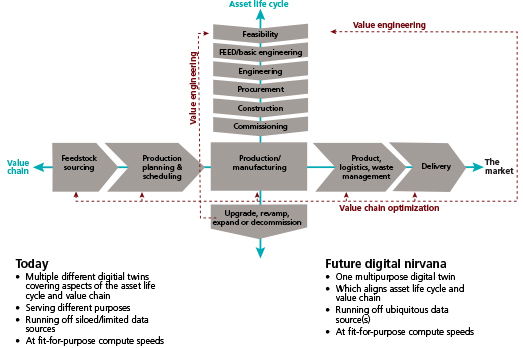- By Joseph Ting
- Factory Automation
Summary
Fast Forward
- The energy and chemical industries need digital twins for effective decision making.
- An integrated production management system digital twin operates across the entire process manufacturing supply chain and asset life cycle.
- Where possible, the cloud should be exploited to host the digital twin.

“What if” analytics run on actual plant data is key to more effective decision making

Decision cycles across industrial environments are becoming increasingly disrupted by proliferation of data, new data sources, and compute speeds within an increasingly volatile business environment. The digital twin is the key to effective decision making in this new world.
Making better decisions, faster, that can be executed perfectly every time is vital for delivering superior results, sustained. However, this is easier said than done. Every individual perspective is underpinned by a series of unique cognitive biases that drive swift action in adversity but make accurately weighing evidence, assessing probabilities, and deciding logically a challenge. Look no further than the constant discrepancy between strategic planning/ambition and results realization (figure 1).

A single view of the truth and analytics is therefore key to situational awareness and effective organizational decision making. But many players in the industry are stuck on determining what type of analytics they need. The solution to this question should be driven by the problem, not by how much analytics can be thrown at data in the hope it will both find the problem and solve it. The desired outcome should influence the type of analytics being sought and the available analytics technology that is fit for purpose (figure 2).

Basic analytics technology can move data around and display key performance indicators (KPIs) to the right people at the right time to enable decision making. They work well for understanding what happened in hindsight. However, increasing plant complexity requires more sophisticated ways of approaching KPIs and targets. In some cases, a rudimentary approach to KPI setting and monitoring can even become ineffective and counterproductive. In this case, deeper analytics technology, using digital twins, is necessary to account for the multidimensional factors and nonlinear trade-offs that make effective decision making a challenge.
The digital twin allows "What if?" and "What's best?" scenarios to be run automatically on actual plant data to determine available strategies that maximize profitability. Experts can then review the recommended strategies to assess the effect of each approach without disrupting the live process.
A digital twin works in the present, mirroring the actual device, system, or process in simulated mode, but with full knowledge of its historical performance and an accurate understanding of its future potential. Therefore, the digital twin can exist at any level within the traditional ISA-95 architecture and can be defined as a decision support tool that enables improved safety, reliability, and profitability in design or operations. It is a virtual/digital copy of a device, system, or process that accurately mimics actual performance, in real time, that is executable and can be manipulated, allowing a better future to be developed.
A digital twin is useful for the entire life cycle of an asset. It is ideally created during the initial study to evaluate the feasibility and process model of the asset. It is then used and further developed during the design, construction, and commissioning of the asset, thereby facilitating the optimal design of the asset and the training of the staff who will operate it. During the bulk of a plant's life cycle, operation, and maintenance, the digital twin can be employed for optimization and predictive maintenance.
The digital twin enables everyone to see inside assets and processes and perceive things that are not being directly measured. They are wired so that insights are instantly available without end users having to wrangle data and models, and they run in a consistent way that everyone can understand and agree on. In this way the digital twin drives agility and convergence in understanding and action across the whole business, for example from engineering to operations, operations to supply chain, reservoir to facilities, and shop floor to board room.
The digital twin aims to be an accurate representation of a device, system, or process over its full range of operation and its full life cycle. Ideally, the digital twin should be able to transition from design to operations with ease.
To achieve the desired levels of accuracy, source data must be gathered in real time and be validated and reconciled to ensure that all physical and chemical laws are respected. Electronic noise and dynamic effects must be eliminated through filtering. Only through this approach can data quality issues be identified and mitigated, and the digital twin be trusted to reflect reality and relied on for the quality and accuracy of its predictions.
Although individual point solution digital twins exist today, a future digital nirvana has one multipurpose digital twin (figure 3). Getting to the future state in one step is unrealistic, and it is likely to be achieved by connecting valuable high-performing individual elements. Therefore, the mantra has to be one of agility-think big, start small, scale fast, and drive adoption.
Some examples of what digital twins are mirroring today include:
- instrument/device
- control system
- 3D design and engineering
- worker
- process/optimization
- energy/utilities
- supply chain.

Considering the above, some can understandably believe that "digital twin" is a marketing term used to repackage certain technologies that have been available in the market for a long time. To some extent that might be true, but not all digital twins are made equal. Their perceived use value varies, for example, a 3D computer-aided design model of a plant may be of less value to a process engineer than a digital copy of the plant's operating conditions and the way in which molecules behave and transform. If anything, the term has been a catalyst for driving clarity and understanding of the value that it represents.
Comprehensive digital twin solutions have been developed for an integrated production management system. These operate across the entirety of the process manufacturing supply chain and asset life cycle to align production management and reliability, energy and supply chain optimization, and strategic asset investment planning (figure 4).

From an enterprise technology stack perspective, digital twin technology can benefit multiple levels of the organization:
- Digital board room. This could comprise a series of business and financial KPIs that are updated in real time as part of an enterprise-wide balanced scorecard. The underlying KPI calculation aims to combine a simple dashboard of measured parameters with integrated logic linked to the process, energy, supply chain, and asset digital twins.
- Simulation and optimization. This could comprise a series of digital twins based on physiochemistry, such as an integrated process/energy/reliability digital twin, operator training simulation twins, and dynamic real-time optimization twins (for process/utility systems).
- Integrated control and safety. This could constitute a digital copy of the live plant and its automation algorithms through the "twin" function of an integrated control and safety system, thereby allowing engineers to conduct fundamental process control tests at an engineering workstation, as well as any proposed adjustments, before they are applied on the live plant.
- Instruments and devices. This could constitute highly intelligent devices, such as pumps, flowmeters, and transmitters, or chemical analyzers that provide total insight into their ongoing performance as well as an ability to adapt to changing duty requirements throughout the measurement device life cycle.
- Operator processes. This could comprise a copy of operator work processes to be executed, which could be tracked and manipulated in real time.
The digital twin promises to be a fantastic tool for strategy execution by ensuring field and line employees have the information they need to understand the bottom-line impact of their day-to-day choices. Strategy execution is also supported because a digital twin can facilitate information flows across organizational boundaries and minimize second-guessing of decisions.
A key challenge of the digital twin is that it needs to exist within a strong governance framework. This includes well-defined business processes, along with clarity about the decision rights and actions for which people are responsible.
One area that needs to be considered is the necessary guidance from subject-matter experts and their associated analytical insights. These can be third parties, but often these experts are in-house yet remote from the operational location. Currently, these insights are obtained when there is a problem or when structured inputs are sent on a regular basis, such as in a weekly meeting or a quarterly service review.
As the energy and chemical industries move away from buying inputs to buying outcomes-as-a-service (XaaS) at both point and holistic solution levels, the digital twin will become increasingly important (figure 5). The digital twin serves as the single basis from which all outcomes are derived. The regularity of the inputs has been replaced with a digital twin predicting when service is optimal, considering current and future operation, and providing the time and best path for all stakeholders as decisions are made. This brings agility and convergence in understanding and action across the whole business.
How do we reach a future digital nirvana with the mantra of agile? Cloud is the answer in many industries, and we believe that it is a key enabler for the digital enterprise of the future. The cloud is already the infrastructure of choice for most business applications, but it remains unexploited for most operational applications. The reason is that most valuable operational applications rely on a continuous feed of plant data, which means they can never be isolated from the plant in a way that a human resources performance management system or capital budgeting system can.
This is partially addressed with "edge devices" living in the "fog" between the real world of the plant and the virtual world of the cloud to bridge the gap. But there is still a potential pathway for a "bad actor" to reach the plant even through an edge device. From an information technology point of view, the cloud offers some compelling savings versus an on-premise approach. But unless the operational risk associated with exposing the plant to the cloud is offset by the value created by the people and applications it serves, its use will remain marginal.
Where possible, the cloud should be exploited to host the digital twin for the following reasons:
- The cloud can engage people and technologies from outside corporate boundaries. Examples include augmentation with georeferenced 3D visualization models. In remote or resource-constrained environments, the cloud allows remote subject-matter experts to join in the day-to-day troubleshooting and profit improvement activities of the plant, using the digital twin, as if they were employees present on site.
- The cloud enables the digital twin to subscribe to external data feeds that can enrich its resolution.
- The cloud allows experts to offer analytical capabilities remotely.
- The cloud supports and nourishes agility with respect to the digital twin. Users can experiment and rapidly deploy new solutions. The cloud makes solution updates trivial and significantly reduces infrastructure costs. Similarly, the cloud reduces the cost of termination-if a solution does not work out as expected, a cloud solution can often be switched off with little-to-no ongoing cost.
Overall, connecting the plant to the wider knowledge pool, and thus completing the digital twin, provides a lot of value. Risks can be managed with governance, cybersecurity measures, and localized operational applications. A focus on the outcomes and an agile organization are key to making the balance right for the plant.
Digitalization is accelerating and disrupting the decision cycle. For the first time, a digital nirvana can be within reach for the energy, chemical, and process manufacturing industries. A digital twin initiative can rally your operations around this vision and create lasting, sustainable business value.

Reader Feedback
We want to hear from you! Please send us your comments and questions about this topic to InTechmagazine@isa.org.


